
The learning needs of students have changed in recent years. With the rise of technology and the internet, more and more educators are turning to virtual classrooms for their teaching needs. However, there’s a lot more to teaching effectively online than just having an internet connection. In this blog post, we’ll explore 9 strategies you can implement to ensure your online classes are engaging and effective. From developing lesson plans with variety to using visuals to enhance student learning, these strategies will help you get the most out of your online class experience. Read on to learn more!
The 9 strategies for teaching effectively online
- Establish a personal connection with your students
- Get to know your students’ learning styles
- Keep your online courses organized
- Incorporate multimedia content
- Encourage Student Interaction
- Use Online Tools to Enhance Teaching
- Be Available and Accessible to Your Students
- Be Creative in Your Approach
- Embrace Technology
How to implement the 9 strategies
- Keep it simple
When you are first starting out, online teaching can feel like a daunting task. There are so many things to keep track of and new technologies to learn. The best way to combat this feeling is to keep your course design and delivery as simple as possible. Do not try to pack too much content into each lesson or make your course overly complicated. Start with the basics and build up from there.
- Engage your students
It is important to engage your students in the learning process by making your lessons interactive and engaging. Use different multimedia tools to liven up your lectures and encourage student participation. Make sure to give students plenty of opportunities to ask questions and receive feedback on their work.
- Promote collaboration
Many online courses are asynchronous, meaning that students do not meet in real-time for classes. This can make it difficult for students to collaborate with one another on projects or assignments. To promote collaboration, consider incorporating group work into your course design. You can also use discussion boards or forums to facilitate student interactions outside of class time.
- Be clear and concise
When communicating with your students online, it is important to be clear and concise in your instructions. Avoid using jargon or technical terms that might not be familiar to everyone in the class. Write out your thoughts in a well-organized manner so that students can easily follow along. Use bullet points or numbered lists whenever possible.
The benefits of teaching effectively online
The strategies listed below can help you to teach effectively online.
- The benefits of teaching effectively online
When you teach online, you can reach a global audience of learners. You can also tailor your teaching to the needs of individual students and create a more engaging and interactive learning environment. Additionally, online teaching can be more flexible and convenient for both teachers and students.
- The challenges of teaching online
While online teaching has many advantages, there are also some challenges that you should be aware of. These include ensuring that students are motivated to learn, managing technical issues, and maintaining student engagement.
The challenges of teaching effectively online
- The challenges of teaching effectively online
The biggest challenge when teaching online is the lack of face-to-face interaction. It can be difficult to build rapport and trust with students when you’re not in the same room. There are a few strategies you can use to overcome this challenge:
-Use video conferencing tools to have regular check-ins with students. This will help you get to know them and their learning styles.
-Encourage student participation by using group work, discussion boards, and other collaborative activities.
-Make yourself available outside of class for questions or concerns. Provide your email address or office hours so students can reach out to you when needed.
Conclusion
Teaching effectively online requires a creative, flexible mindset and the willingness to try new things. By implementing the nine strategies listed above, you can create an engaging and productive learning environment for students. From leveraging technology to encouraging collaboration, these strategies offer unique ways to ensure your students stay engaged and motivated even when they are not together in person. With the right tools, planning, and creativity, teaching online can be just as effective—if not more so—than traditional face-to-face instruction.
